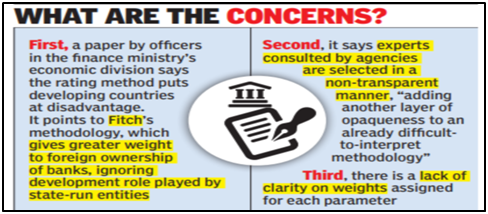Why in News?
- In an essay ‘Understanding a Sovereign’s Willingness to Pay Back: A Review of Credit Rating Methodologies’, the office of the CEA in the Finance Ministry has called for urgent reforms and transparency in the process of sovereign credit rating.
- According to the Chief Economic Advisor (CEA), methodologies used by agencies (CRAs) are heavily loaded against developing countries like India due to an “over-reliance” on non-transparent and subjective qualitative factors.
What’s in Today’s Article?
- What is a Sovereign Credit Rating?
- Issues with the Methodology of Credit Rating
- Recommendations Given by the CEA to Reform Credit Rating
What is a Sovereign Credit Rating?
- A sovereign credit rating is a measurement of a government’s ability to repay its debt, with a low rating indicating high credit risk.
- Typically, rating agencies use various parameters to rate a sovereign. These include growth rate, inflation, government debt, short-term external debt as a percentage of GDP and political stability.
- A favourable credit card rating enhances credibility and signifies a positive track record of timely loan repayment in the past.
- It assists banks and investors in evaluating loan applications and determining the interest rates to be offered.
- The global credit rating industry is highly concentrated, with three leading agencies: Moody's, Standard & Poor's, and Fitch.
- While S&P and Fitch rate India at BBB, Moody’s rates the South Asian country at Baa3, which indicates the lowest possible investment grade.
- This is despite India climbing the ladders from the 12th largest economy in the world in 2008 to the 5th largest in 2023, with the 2nd-highest growth rate recorded during the period among all the comparator economies.
Issues with the Methodology of Credit Rating:

- A quantitative analysis showed that over half the credit ratings are determined by the qualitative component.
- Institutional Quality, proxied mostly by the World Bank’s Worldwide Governance Indicators (WGIs), emerges as the foremost determinant of a developing economy’s credit rating.
- This presents a problem since these metrics tend to be non-transparent, perception-based, and derived from a small group of experts, and cannot represent the willingness to pay the sovereign.
- Their effect on the ratings is non-trivial since it implies that to earn a credit rating upgrade, developing economies must demonstrate progress along arbitrary indicators.
Recommendations given by the CEA to Reform Credit Rating:
- The CEA recommended relying mainly on a country’s debt repayment history to determine its ‘willingness to pay’, instead of “less-than-optimal” qualitative information.
- Such a model will do enormous good to the credibility of the CRAs.
- Qualitative information and judgement can be the last resort when all other options for applying authentic, verifiable information are precluded.
- Even if governance indicators are to be relied upon, they must be based on clear, well-defined, measurable principles rather than subjective judgements by CRAs.
- CRAs tend to have a detailed database of best practices from around the world, which they apparently rely upon to form their judgements.
- This knowledge must be shared with the countries they rate so that appropriate action can be taken on a sovereign’s part to improve its creditworthiness.









